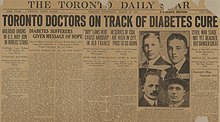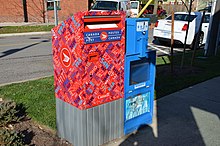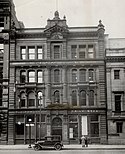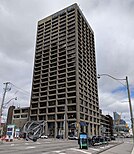Toronto Star
 Front page of the January 23, 2013, edition of the Toronto Star | |
| Type | Daily newspaper |
|---|---|
| Format | Broadsheet |
| Owner(s) | Toronto Star Newspapers Ltd. (subsidiary of Torstar) |
| Publisher | Jordan Bitove |
| Editor | Anne Marie Owens |
| Founded | 1892 (as Evening Star) |
| Political alignment | Social liberalism[1][2][3][4] |
| Headquarters | 8 Spadina Avenue Toronto, Ontario M5V 0S8 |
| Circulation | 193,050 weekdays 290,153 Saturdays 185,159 Sundays in 2018[5] |
| ISSN | 0319-0781 |
| OCLC number | 137342540 |
| Website | www |
The Toronto Star is a Canadian English-language broadsheet daily newspaper. It is owned by Toronto Star Newspapers Limited, a subsidiary of Torstar Corporation and part of Torstar's Daily News Brands division.[6]
The newspaper was established in 1892 as the Evening Star and was later renamed the Toronto Daily Star in 1900, under Joseph E. Atkinson. Atkinson was a major influence in shaping the editorial stance of the paper, with the paper reflecting his principles until his death in 1948.[7] His son-in-law, Harry C. Hindmarsh, shared those principles as the paper's longtime managing editor while also helping to build circulation with sensational stories, bold headlines and dramatic photos.[8] The paper was renamed the Toronto Star in 1971 and introduced a Sunday edition in 1977.[9]
History
[edit]The Star was created in 1892[10] by striking Toronto News printers and writers, led by future mayor of Toronto and social reformer Horatio Clarence Hocken, who became the newspaper's founder,[11] along with another future mayor, Jimmy Simpson.
The Star was first printed on Toronto World presses, and at its formation, The World owned a 51 percent interest in it[12] as a silent partner.[13] That arrangement only lasted for two months, during which time it was rumoured that William Findlay "Billy" Maclean, The World's proprietor, was considering selling the Star to the Riordon family.[a] After an extensive fundraising campaign among the Star staff, Maclean agreed to sell his interest to Hocken.[13][15]
The paper did poorly in its first few years. Hocken sold out within the year, and several owners followed in succession until railway entrepreneur William Mackenzie bought it in 1896.[16] Its new editors, Edmund E. Sheppard and Frederic Thomas Nicholls, moved the entire Star operation into the same building used by the magazine Saturday Night.[17]
Under Atkinson
[edit]
Joseph E. "Holy Joe" Atkinson, backed by funds raised by supporters of Prime Minister Wilfrid Laurier, bought the paper on December 13, 1899.[17] The supporters included Senator George Cox, William Mulock, Peter Charles Larkin and Timothy Eaton.[18] Atkinson became the controlling shareholder of the Star.[19] The Star was frequently criticized for practising the yellow journalism of its era. For decades, the paper included heavy doses of crime and sensationalism, along with advocating social change.
Atkinson was the Star's editor from 1899 until his death in 1948.[20] The newspaper's early opposition and criticism of the Nazi regime[21] saw it become one of the first North American papers to be banned in Germany.[22] Atkinson had a social conscience. He championed many causes that would come to be associated with the modern welfare state: old age pensions, unemployment insurance, and health care. The Government of Canada Digital Collections website describes Atkinson as:
a "radical" in the best sense of that term.... The Star was unique among North American newspapers in its consistent, ongoing advocacy of the interests of ordinary people. The friendship of Atkinson, the publisher, with Mackenzie King, the prime minister, was a major influence on the development of Canadian social policy.[23]
Shortly before his death in 1948, Joseph E. Atkinson transferred ownership of the paper to a charitable organization given the mandate of continuing the paper's liberal tradition.[24] In 1949, the Province of Ontario passed the Charitable Gifts Act,[b] barring charitable organizations from owning large parts of profit-making businesses,[25] that effectively required the Star to be sold.[c]
Atkinson's will had directed that profits from the paper's operations were "for the promotion and maintenance of social, scientific and economic reforms which are charitable in nature, for the benefit of the people of the province of Ontario" and it stipulated that the paper could be sold only to people who shared his social views.[27] The five trustees of the charitable organization circumvented the Act by buying the paper themselves and swearing before the Supreme Court of Ontario to continue what became known as the "Atkinson Principles":[28]

- A strong, united and independent Canada
- Social justice
- Individual and civil liberties
- Community and civic engagement
- The rights of working people
- The necessary role of government
These principles continue to affect the Star's editorial stances. In February 2006, Star media columnist Antonia Zerbisias wrote on her blog:
Besides, we are the Star which means we all have the Atkinson Principles—and its multi-culti values—tattooed on our butts. Fine with me. At least we are upfront about our values, and they almost always work in favour of building a better Canada.[29]
Other early media ventures
[edit]Under Atkinson, the Star launched several other media initiatives, including a weekend supplemental magazine, the Star Weekly, from 1910 to 1973. From 1922 to 1933, the Star was also a radio broadcaster on its station CFCA, broadcasting on a wavelength of 400 metres (749.48 kHz); its coverage was complementary to the paper's reporting.[30] The station was closed following the establishment of the Canadian Radio Broadcasting Commission (CRBC) and the introduction of a government policy that, in essence, restricted private stations to an effective radiated power of 100 watts.[30] The Star would continue to supply sponsored content to the CRBC's CRCT station—which later became CBC station CBL—an arrangement that lasted until 1946.[30]
1971–present
[edit]In 1971, the newspaper was renamed The Toronto Star and moved to a modern International-style office tower at One Yonge Street by Queens Quay. The original Star building at 80 King Street West was demolished to make room for First Canadian Place.
The Star expanded during the 1970s with the introduction of a Sunday edition in 1973 and a morning edition in 1981.[7]
In 1992, its printing plant was moved to the Toronto Star Press Centre at the Highway 407 & 400 interchange in Vaughan.[31] In September 2002, the logo was changed, and "The" was dropped from the masthead. During the 2003 Northeast blackout, the Star printed the paper at a press in Welland, Ontario. The newspaper's former printing plant was housed at One Yonge Street until the Toronto Star Press Centre opened.
Until the mid-2000s, the front page of the Toronto Star had no third-party advertising aside from upcoming lottery jackpot estimates from the Ontario Lottery and Gaming Corporation (OLG).
On May 28, 2007, the Star unveiled a redesigned paper that featured larger type, narrower pages, fewer and shorter articles, renamed sections, a more prominent focus on local news, and less focus on international news, columnists, and opinion pieces.[32] However, on January 1, 2009, the Star reverted to its previous format. Star P.M., a free newspaper in PDF format that could be downloaded from the newspaper's website each weekday afternoon, was discontinued in October 2007, thirteen months after its launch.
On January 15, 2016, Torstar confirmed the closure of its Vaughan printing presses and indicated that it would outsource printing to Transcontinental Printing, leading to the layoff of all 285 staff at the plant, as Transcontinental had its own existing facility, also in Vaughan.[33] The newspaper said the closure was effected so it could better focus on its digital outlets.[34]
In February 2018, the Toronto Star suspended its internship program indefinitely to cut its costs.[35] Long a source of Canada's next generation of journalists, the paid positions were seen by journalists and program alumni as a vital part of the national industry, and their suspension, a sign of its continuing decline.[36] In 2020, the internship program returned.[37]
In April 2018, the Toronto Star expanded its local coverage of Vancouver, Calgary, Edmonton and Halifax with rebranded daily newspapers, previously known as Metro, as StarMetro, which was a joint venture between Torstar (90%) and Swedish media company Metro International (10%).[38][39][40] In October 2018, the Toronto Star acquired iPolitics, a political news outlet. It ceased to own the property in 2022.[41][42]
On December 20, 2019, all StarMetro editions ceased publication amid the popularity and resultant growth of news apps on mobile devices.[43][44]
The newspaper was acquired by NordStar Capital on May 26, 2020, after the board of Torstar voted to sell the company to the investment firm for CA$52 million—making Torstar a privately held company.[45] The deal was expected to be approved by Torstar's shareholders and to close by the end of 2020.[46] Canadian Modern Media Holdings made an offer of $58 million on July 9, 2020;[47] NordStar subsequently increased its offer to $60 million, effectively ending the bidding war.[47] A vast majority of shareholders subsequently voted in favour of the deal.[48] The takeover was approved by an Ontario judge on July 27, 2020.[49] An appeal of the judgement by another prospective purchaser failed on July 31 when Ontario Superior Court Justice Michael Penny dismissed the motion.[50] The deal was expected to close during the following week.[51][52]
In November 2022, the newspaper moved its headquarters from the Toronto Star Building located on Yonge Street to a new location on Spadina Avenue at Front Street.[53][54] [55][56]
Content
[edit]Editorial position
[edit]Like its competitor The Globe and Mail, the Star covers "a spectrum of opinion that is best described as urban and Central Canadian" in character. The Star is generally centrist and centre-left, and is more socially liberal than The Globe and Mail.[57] The paper has aligned itself over the years with the progressive "Atkinson principles" named for publisher Joseph E. Atkinson,[58] who was editor and publisher of the paper for 50 years.[59] These principles included social justice and social welfare provision, as well as individual rights and civil liberties.[59] In 1984, scholar Wilfred H. Kesterton described the Star as "perpetually indignant" because of its social consciousness.[57] When Atkinson's son Joseph Story Atkinson became president of the Star in 1957, he said, "From its inception in 1892, the Star has been a champion of social and economic reform, a defender of minority rights, a foe of discrimination, a friend of organized labour and a staunch advocate of Canadian nationhood."[59]
Another of the "Atkinson principles" has been a "strong, united and independent Canada"; in a 1927 editorial, the paper wrote, "We believe in the British connection as much as anybody does but on a self-respecting basis of equality, of citizenship, and not on the old basis of one country belonging to the other."[59] The paper was historically wary of American influence,[59] and during the debates over the North American Free Trade Agreement, the paper was frequently critical of free trade and expressed concerns about Canadian sovereignty.[60] The paper has been traditionally supportive of official bilingualism and maintaining Canadian unity in opposition to Quebec separatism.[59]
In the 1980s, Michael Farber wrote in the Montreal Gazette that the Star's coverage was Toronto-centric to the point that any story was said to carry an explanation as to "What it means to Metro."[61] Conversely, Canadian sociologist Elke Winter wrote in 2011 that the Toronto Star was less "Toronto-centric" than its rival, The Globe and Mail, writing that the Star "consciously reports for and from Canada's most multicultural city" and catered to a diverse readership.[57]
The advent of the National Post in 1998 shook up the Toronto newspaper market.[62] In the upheaval that followed, editorial spending increased and there was much turnover of editors and publishers.[63]
Election endorsements
[edit]In the 50 years to 1972, the Star endorsed the Liberal Party in each federal general election.[64] In the fifteen federal elections between 1968 and 2019, the Star has endorsed the Liberal Party eleven times, the New Democratic Party twice, and the Progressive Conservative Party twice.[58]
Elections in which the Star did not endorse the Liberals took place in 1972 and 1974 (when it endorsed the Progressive Conservatives), and 1979 and 2011 (when it endorsed the NDP).[64][58] In the 2011 election, the Star endorsed the NDP under Jack Layton,[1] but to avoid vote splitting that could inadvertently help the Conservatives under Stephen Harper, which it saw as the worst outcome for the country, the paper also recommended Canadians vote strategically by voting for "the progressive candidate best placed to win" in certain ridings.[65] For the 2015 election, the Star endorsed the Liberal Party under Justin Trudeau,[66] and did so again in the 2019 federal election.[67]
In Toronto's non-partisan mayoral elections, the Star endorsed George Smitherman in 2010[68] and John Tory in 2014[69] and 2018.[70]
Features
[edit]The Star is one of the few Canadian newspapers that employs a "public editor" (ombudsman) and was the first to do so. Its newsroom policy and journalistic standards guide is also published online.[71]
The Star states that it favours an inclusive, "big tent" approach, not wishing to attract one group of readers at the expense of others. It publishes regular features on real estate (including condominiums), individual neighbourhoods (and street name etymologies), shopping, cooking, dining, alcoholic beverages (right down to having an exclusive on the anti-competitive practices of the Beer Store that led to major reforms on the sale of alcohol in Ontario grocery stores in 2015 by Premier Kathleen Wynne and Ed Clark), automobiles (as Wheels), and travel destinations.
Products
[edit]Website
[edit]The Star launched its website in 1996.[7] In October 2012, the Star announced its intention to implement a paywall on its website, thestar.com,[72] effective August 13, 2013. Readers with daily home delivery had free access to all digital content. Those without a digital subscription could access 10 articles a month.[73][74] The Star removed its paywall on April 1, 2015,[75] and revived it in 2018.[76]
Mobile app
[edit]On September 15, 2015, the Toronto Star released the Star Touch tablet app, which was a free interactive news app with interactive advertisements. It was discontinued in 2017. At launch, it was only available for the iPad, which uses iOS. Based on a similar app for Montreal-based La Presse released in 2013, Star Touch is the first such app for any English-language news organization, quality-wise.[77] In slightly over 50 days since launch, the app had reached the 100,000-download milestone.[78] The Android version was launched on December 1, 2015.[79] The iOS version is rated 12+ by Apple's App Store guidelines[80] and the Android version is rated Mature 17+ by the Entertainment Software Rating Board (ESRB).[81]
Circulation
[edit]
The Toronto Star has seen, like most Canadian daily newspapers, a decline in circulation. Its total circulation dropped by 22 percent to 318,763 copies daily from 2009 to 2015.[82]
Offices
[edit]The Toronto Star has been located at several addresses since 1892.[9]
- 1892: 83 Yonge Street (shared with The Toronto World)
- 1896: 26–28 Adelaide Street West
- 1905: 18–20 King Street West
- 1929: 80 King Street West (Old Toronto Star Building)
- 1970: One Yonge Street
- 2022: 8 Spadina Avenue[55][83]
Notable staff
[edit]Publishers
[edit]- Joseph E. Atkinson (1899–1948)
- Joseph S. Atkinson (1948–1966)
- Beland Honderich (1966–1988)
- David R. Jolley (1988–1994)
- John Honderich (1995–2004)
- Michael Goldbloom (2004–2006)
- Jagoda Pike (2006–2008)
- Donald Babick (2008)
- John D. Cruickshank (2009–2016)
- John Boynton (2017–2020)
- Jordan L. Bitove (since 2020)
Journalists and columnists
[edit]- Pierre Berton
- Tony Burman
- Peter Calamai
- Morley Callaghan
- June Callwood
- Greg Clark
- Jeremy Clarkson
- Erin Combs
- Daniel Dale
- Susan Delacourt
- Rosie DiManno
- Robyn Doolittle
- Milt Dunnell
- Joe Fiorito
- Graham Fraser
- Michael Geist
- Carol Goar
- Alison Gordon
- Richard Gwyn
- Matthew Halton
- Tom Harpur
- Chantal Hébert
- Ernest Hemingway[84]
- W. A. Hewitt[85]
- Kim Hughes[86][87]
- Cathal Kelly
- Marc and Craig Kielburger
- Naomi Klein
- Faisal Kutty
- Michele Landsberg
- Gary Lautens
- Duncan Macpherson
- Linda McQuaig
- Earl McRae
- Heather Mallick
- Lou Marsh
- Peter C. Newman
- Cleo Paskal
- Angelo Persichilli[88]
- Jim Proudfoot
- Ben Rayner[89][90]
- Ellen Roseman
- Robert Service
- Haroon Siddiqui
- Gordon Sinclair
- Randy Starkman
- Walter Stewart
- Tanya Talaga
- Charles Templeton
- Ellie Tesher
- James Travers
- Thomas Walkom
- Claire Wallace
- Antonia Zerbisias
- Montague Birrell Black
Cartoonists
[edit]See also
[edit]- Grant v Torstar Corp
- Media in Canada
- List of media outlets in Toronto
- List of newspapers in Canada
- List of the largest Canadian newspapers by circulation
Notes
[edit]- ^ Owners of the Riordon Pulp and Paper Company, and investors in The Hamilton Spectator, Toronto Mail and the Toronto Evening News.[14]
- ^ The Charitable Gifts Act, R.S.O. 1990, c. C.8 , repealed in 2009 by the Good Government Act, 2009, S.O. 2009, c. 33, Sch. 2
- ^ But the Act's repeal in 2009 did not mean that charities in Ontario could then set up for-profit companies or pursue business activities.[26]
References
[edit]Citations
[edit]- ^ a b "Toronto Star endorses the NDP". Toronto Star. April 30, 2011. Archived from the original on May 3, 2011. Retrieved April 30, 2011.
- ^ "But vote strategically". Toronto Star. April 30, 2011. Archived from the original on May 3, 2011. Retrieved April 30, 2011.
- ^ "World Newspapers and Magazines: Canada". Worldpress.org. 2019. Retrieved December 27, 2019.
- ^ "Star's choice: Dion, Liberals". Toronto Star. October 11, 2008. Retrieved October 12, 2008.
- ^ "Toronto Star Media Kit" (PDF). News Media Canada. Retrieved March 7, 2020. Numbers are based on the total circulation (print plus digital editions).
- ^ "Toronto Star Newspapers Ltd". Bloomberg. Retrieved March 8, 2018.
- ^ a b c d "Toronto Star". www.thecanadianencyclopedia.ca. Historica Canada. December 20, 2021. Retrieved August 30, 2022.
- ^ Harkness, Ross (1963). J.E. Atkinson of the Star. Toronto: University of Toronto Press.
- ^ a b "History of the Toronto Star". Toronto Star. September 23, 2016. Retrieved April 5, 2017.
- ^ "The Toronto Star | Canadian newspaper". Britannica.com. Retrieved February 15, 2019.
- ^ "Profile – Hocken, Horatio Clarence". Parlinfo. Parliament of Canada. Archived from the original on July 11, 2019. Retrieved February 15, 2019.
- ^ Archer 1947, p. 3.
- ^ a b Sotiron 2005.
- ^ Rutherford 1982.
- ^ Archer 1947, pp. 4–5.
- ^ Archer 1947, pp. 5–6.
- ^ a b Archer 1947, p. 6.
- ^ Otto, Stephen A. (2005). "Larkin, Peter Charles". In Cook, Ramsay; Bélanger, Réal (eds.). Dictionary of Canadian Biography. Vol. XV (1921–1930) (online ed.). University of Toronto Press.
- ^ James H. Marsh (1999). The Canadian Encyclopedia. The Canadian Encyclopedia. p. 2368. ISBN 9780771020995. Retrieved July 10, 2020.
- ^ "History of the Toronto Star". thestar.com. September 23, 2016. Retrieved February 29, 2020.
- ^ "A Canadian Observer". Vancouver Holocaust Education Centre. Archived from the original on February 5, 2012. Retrieved September 3, 2011.
- ^ Phillips, Andrew (November 1, 2017). "125 years of speaking out". Toronto Star. Retrieved January 23, 2018.
- ^ "Bienvenue au site Web Bibliothèque et Archives Canada / Welcome to the Library and Archives Canada website". Collections Canada. August 30, 2012. Archived from the original on July 6, 2011. Retrieved August 17, 2013.
- ^ Powell, Betsy (November 6, 2002). "Atkinson's will kept Star's resolve". Toronto Star. Toronto. Archived from the original on October 23, 2012. Retrieved January 12, 2011.
- ^ Bourgeois, Donald. "The Charitable Gifts Act: A Commentary". Retrieved January 12, 2011.
- ^ Lazier, Kate; Manwaring, Susan M. (December 2009). "Ontario Government passes Good Government Act that includes positive changes for charities" (PDF). Miller Thomson.
- ^ Martin, Sandra (November 8, 2005). "Beland Honderich, 86". The Globe and Mail.
- ^ "Atkinson Principles". Torstar. Retrieved August 2, 2013.
- ^ Zerbisias, Antonia (February 20, 2006). "Kartoon Kontroversy Kontinues". Archived from the original on March 23, 2006. Retrieved August 2, 2013.
- ^ a b c Plummer, Kevin (March 22, 2014). "Historicist: An Invisible Giant". torontoist.com.
- ^ "Torstar's Vaughan Press Centre celebrates 20th anniversary". Toronto Star. September 6, 2012.
- ^ Kuntz, J. Fred (May 28, 2007). "You spoke, we listened: Here are the changes". Toronto Star. Toronto. Retrieved May 25, 2010.
- ^ "Torstar to sell printing plant in Vaughan, close to 300 jobs affected". toronto.citynews.ca. January 15, 2016.
- ^ Sagan, Aleksandra (January 15, 2016). "Torstar lays off more than 300 production, editorial staff, selling staff". Toronto Sun.
- ^ "Toronto Star Suspending Internship Programs Indefinitely". Canadaland. February 13, 2018.
- ^ "Why the Toronto Star internship program was unique". J-Source. February 21, 2018.
- ^ "Toronto Star welcomes back internship program with seven young reporters". The Toronto Star. December 20, 2020. ISSN 0319-0781. Retrieved December 28, 2021.
- ^ "Torstar hiring 20 reporters as it rebrands and revamps Metro Urban dailies across Canada". Financial Post. The Canadian Press.
- ^ Healing, Dan. "StarMetro? Toronto Star publisher rebranding free daily newspapers across Canada – cites appetite for 'progressive voice'". Calgary Herald. The Canadian Press. Retrieved March 30, 2019.
- ^ Popplewell, Brett (May 10, 2018). "Inside the Toronto Star's Bold Plan to Save Itself". The Walrus. Retrieved March 30, 2019.
- ^ "Tortar signs agreement to purchase political website iPolitics". CBC. Retrieved March 30, 2019.
- ^ "Torstar to purchase iPolitics media outlet". Cision. Retrieved March 30, 2019.
- ^ "Torstar shutting down StarMetro papers across Canada". CityNews. Rogers Digital Media. November 19, 2019. Retrieved December 27, 2019.
- ^ "Toronto Star shutting down StarMetro newspapers". CBC.ca. Canadian Broadcasting Corporation. November 19, 2019. Retrieved December 27, 2019.
- ^ The Canadian Press (May 26, 2020). "Torstar agrees to $52M sale to NordStar Capital". CBC News. Retrieved July 20, 2020.
- ^ "Torstar to be sold, taken private in $52-million deal". Toronto.com. May 26, 2020. Retrieved May 27, 2020.
- ^ a b "Surprise $60-million bid from NordStar locks up acquisition of Torstar". Toronto Star. Retrieved July 12, 2020.
- ^ "Shareholders have given a proposed $60 million takeover of the Toronto Star's publisher their seal of approval". St Catharines Standard. Retrieved July 21, 2020.
- ^ "Judge approves NordStar's $60-million takeover of Torstar – The Globe and Mail". www.theglobeandmail.com. Retrieved July 28, 2020.
- ^ "Torstar Corporation Announces Dismissal of Stay Motion in Connection with Arrangement with NordStar Capital LP". Financial Times. July 31, 2020. Retrieved August 1, 2020.
- ^ "NordStar takeover of Toronto Star publisher cleared to go ahead early next week". Toronto Star. Retrieved August 1, 2020.
- ^ "Torstar Corporation Announces Dismissal of Stay Motion in Connection with Arrangement with NordStar Capital LP". Financial Times. July 31, 2020. Retrieved August 1, 2020.
he Ontario Superior Court of Justice (Divisional Court) has dismissed a motion for a stay of the final order
- ^ Zwolinski, Mark (November 4, 2022). "Proudfoot Corner: Memories of 1 Yonge St. as Toronto Star prepares to move". thestar.com. Retrieved May 7, 2023.
- ^ "Contact Us". The Toronto Star. February 9, 2021. Retrieved May 7, 2023.
- ^ a b "Opinion | the Star's move requires us to rethink what our office should be, post-pandemic". The Toronto Star. December 29, 2021.
- ^ Rubin, Josh (December 14, 2022). "Shopify confirms it no longer intends to expand to massive new Toronto office space, citing shift toward remote-first". thestar.com. Retrieved May 7, 2023.
Several other companies have already moved into the Well, including the Star, which recently moved from its long-time office at 1 Yonge St.
- ^ a b c Elke Winter, Us, Them and Others: Pluralism and National Identities in Diverse Societies (University of Toronto Press, 2011), p. 96.
- ^ a b c Kenyon Wallace, How the Star is making its political endorsements more transparent, Toronto Star (May 26, 2018).
- ^ a b c d e f Tamar Harris, Through constant change, Atkinson Principles endure, Toronto Star (November 4, 2017).
- ^ Perrella, Andrea M.L. (1995). Guy Lachapelle (ed.). "Editorials and the Free Trade Agenda: Comparison of Law Press and the Toronto Star Quebec Under Free Trade: Making Public Policy in North America". Quebec Under Free Trade: Making Public Policy in North America. Presses de l'Université du Québec: 276–79.
- ^ Farber, Michael (August 27, 1985). "Stock deal ends talk of takeover". Montreal Gazette. p. A-3.
- ^ "As the Globe turns – Macleans.ca". Macleans. July 9, 2009. Retrieved November 14, 2017.
- ^ Orth, Maureen. "Black Mischief". The Hive. Retrieved November 14, 2017.
- ^ a b Kathy English, Why do newspapers endorse?, Toronto Star (October 11, 2008).
- ^ "But vote strategically". Toronto Star. April 30, 2011. Archived from the original on March 21, 2014.
- ^ "Toronto Star endorses Liberal leader Justin Trudeau for prime minister". Toronto Star. October 9, 2015.
- ^ "Liberals are the best choice for Canada". Toronto Star. October 16, 2019.
- ^ "The Star's choices for Toronto mayor: George Smitherman". Toronto Star. October 17, 2010.
- ^ "John Tory is the best choice to lead Toronto: Editorial". Toronto Star. October 21, 2014.
- ^ "John Tory is the best choice for Toronto now". Toronto Star. October 19, 2018.
- ^ "Toronto Star Newsroom Policy and Journalistic Standards Guide". Toronto Star. December 7, 2011. Retrieved August 17, 2013.
- ^ "The Star to launch digital subscription". Toronto Star. October 29, 2012.
- ^ "Toronto Star launches digital subscriptions: Publisher". Toronto Star. August 13, 2013.
- ^ "Toronto Star moving behind paywall". CBC News. August 13, 2013. Retrieved February 18, 2019.
- ^ "Note to Readers: Star to end paid digital subscriptions on April 1". Toronto Star. March 7, 2015.
- ^ "Registration". Toronto Star. June 28, 2018.
- ^ "Toronto Star makes news with innovative Star Touch tablet app". Toronto Star. September 15, 2015.
- ^ "Toronto Star Touch hits 100,000 downloads. Have you tried it?". Toronto Star. November 13, 2015.
- ^ "Toronto Star Touch launches on Android". Toronto Star. November 30, 2015.
- ^ "iTunes". iTunes.
- ^ "Google".
- ^ a b "Daily Newspaper Circulation Data". News Media Canada. Retrieved December 16, 2017.
- ^ "The Well blends redevelopment with a historic community in Toronto's west end". The Globe and Mail. January 3, 2023.
- ^ A collection of Hemingway's work in the Star was published as Dateline: Toronto
- ^ Sullivan, Jack (December 8, 1953). "After 60 Years In Sport: 500 Sportsmen To Honor William "Billy" Hewitt". Winnipeg Free Press. Winnipeg, Manitoba. p. 19.
 ; Sullivan, Jack (December 8, 1953). "Sportsmen Honour W. A. (Billy) Hewitt at Dinner Tonight". The Kingston Whig-Standard. Kingston, Ontario. The Canadian Press. p. 11.
; Sullivan, Jack (December 8, 1953). "Sportsmen Honour W. A. (Billy) Hewitt at Dinner Tonight". The Kingston Whig-Standard. Kingston, Ontario. The Canadian Press. p. 11.
- ^ Hughes, Kim (May 18, 2008). "The soundtrack of a generation". Toronto Star. Retrieved September 28, 2010.
- ^ Hughes, Kim (July 8, 2007). "They loved, lusted, lost". Toronto Star. Retrieved September 28, 2010.
- ^ "Harper finds new communication director in ranks of ethnic media". The Globe and Mail. August 31, 2011. Archived from the original on September 6, 2011.
- ^ Gordon, Cameron. "Toronto's Star... Ben Rayner In a rockcritics.com interview". Rockcritics.com. Retrieved September 8, 2013.
- ^ "Ben Rayner". Toronto Star. Retrieved September 8, 2013.
Sources
[edit]- Archer, William L. (1947). Joe Atkinson's Toronto Star: The Genius of Crooked Lane. Montreal: Montreal [Zeta Psi Fraternity].
- Rutherford, Paul (1982). "Riordon (Riordan), John". In Halpenny, Francess G (ed.). Dictionary of Canadian Biography. Vol. XI (1881–1890) (online ed.). University of Toronto Press.
- Sotiron, Minko (2005). "Maclean, William Findlay". In Cook, Ramsay; Bélanger, Réal (eds.). Dictionary of Canadian Biography. Vol. XV (1921–1930) (online ed.). University of Toronto Press.
Further reading
[edit]- Harkness, Ross (1963). J.E. Atkinson of the Star. Toronto: University of Toronto Press. OCLC 1402965.
- Templeton, Charles (1983). "Inside the Toronto Star". Charles Templeton, an anecdotal memoir. Toronto: McClelland & Stewart. ISBN 978-0-7710-8545-1. OCLC 11158533. Retrieved February 13, 2010.
- Vincent, Trista (March 1999). "Manufacturing Concern :: Ryerson Review of Journalism". Archived from the original on March 27, 2012. Retrieved January 6, 2011.
- Walkom, Thomas L (1994). Rae Days. Toronto: Key Porter Books. ISBN 978-1-55013-598-5. OCLC 30669140.
External links
[edit]- Official website

- Toronto Star – The Canadian Encyclopedia
- Toronto Star – Encyclopædia Britannica
- Toronto Star photograph archive – Toronto Public Library



